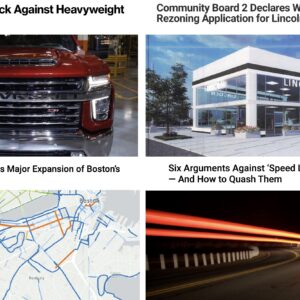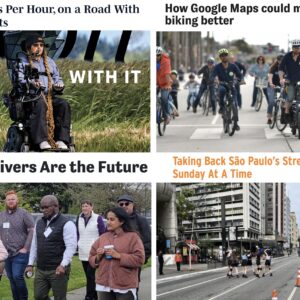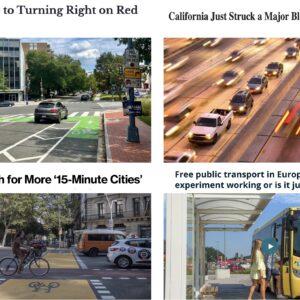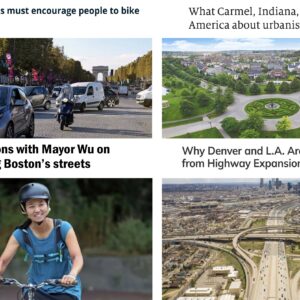– Sure, 2009 was no 2008, but in the U.S. we drove less, and walked, biked, and took the bus significantly more than in 2001.
– At the Los Angeles Streets Summit, NYC transpo commish Janette Sadik-Khan’s keynote speech produced some interesting perspectives.
– Much is often made of the dangers of teen driving—but it turns out that people over 75 are just as, if not more, dangerous behind the wheel.
– Every year or so, a new study shows that transportation costs make suburban and exurban housing less affordable than the real estate market would have it seem. Here’s the latest one.
– At one of the world’s largest environmental conferences, held in Eugene last week, bikes played a minor but notable role.
– Bicycles are making a comeback in China—where e-bikes are fast becoming the norm.
– In Daytona Beach, Florida an interesting dilemma arises over beach access—without beachfront parking, the only way locals who don’t live within walking distance of the water can access the beach is by driving. On the beach. Which is legal, even though people get run over.
– In Mumbai, India, monthly ciclovias may be mandated as part of the city’s pollution control efforts.
– A street video from a hundred years ago helps make the case for shared space, that is, less separation of modes.
– In Molalla, Oregon, a man stopped his car, got out, and beat up another man who shouted after him that he was driving too fast.
– Another road rage incident, this one over an Obama bumper sticker, has been making the news rounds.
– Streetsblog weighs in again on why language matters—and advocates against using the term “freak accident” to describe the all-too-predictable results of reckless driving (they’d also prefer to leave the terms “alternative transportation” and “avid cyclist” by the wayside).






Thanks for reading.
BikePortland has served this community with independent community journalism since 2005. We rely on subscriptions from readers like you to survive. Your financial support is vital in keeping this valuable resource alive and well.
Please subscribe today to strengthen and expand our work.
Traffic engineers never refer to “car accidents” – they refer to collisions or crashes. Because it’s their job to figure out ways to make collisions not happen – if they do, it’s a failure of the system, not a accident.
Is there a missing link in the last (Streetsblog) item? Thanks for the reliable Monday morning distraction.
Nathan. There was, but I’ve added it now. Cheers. – Editor
My experience in India was that the chaos of the mix of cars, animals, bikes, pedestrians created a space that was actually fairly safe even though it seemed dangerous from my perspective of living here. In the 3 weeks I was there I saw only 1 accident.
The exploding whale incident ended up under ODOT’s jurisdiction because ocean beaches are considered state highways (speed limit is 20, yielding to beachcombers and wildlife). I don’t think we really have a huge problem with cars on the beach here mostly because we don’t have Florida drivers (they have their own tag on Fark; ’nuff said), and the Californian drivers don’t seem to realize that you can do that here (thank $DEITY).
Though the road rage incidents make me think we should keep the death penalty around to clean up some of the excess white trash we have blowing around…
Much is often made of the dangers of teen driving—but it turns out that people over 75 are just as, if not more, dangerous behind the wheel.
yeah, but theyve got the aarp, so nothing will ever come of it.
“transpo commish”?
Sigh…..
– Sure, 2009 was no 2008, but in the U.S. we drove less, and walked, biked, and took the bus significantly more than in 2001.
No, not necessarily. From your link:
“The downside to the NHTS is how infrequently the survey is conducted, which makes it difficult to determine how much the 2009 data reflects a larger trend, and how much may be due to temporary changes brought on by fluctuating gas prices and the recession.”
Translation: The data might be crap, but hey, it supports our conclusion, so we’re going to skip the uncomfortable statistical stuff and just say it’s true.
You know, it’s interesting to watch how increasingly often “surveys” are used to support conclusions about human behavior. Almost as interesting as how often they seem to be wrong, or just plain made up.
A street video from a hundred years ago helps make the case for shared space, that is, less separation of modes.
You mean when the average speed of a streetcar and an auto was 15 mph, death and injury was common, the average person could not afford a private vehicle, and city streets largely didn’t look like this?
The video of San Fran from 1906 is, for me, a clear example of the single most significant factor in the cluster that is modern urban transportation systems: speed.
In the video, the street appears to be in complete chaos, yet everyone is managing just fine because they have plenty of time to percieve and react.
Traffic control systems are our self-inflicted punishment for reckless and excessive exploitation of technology before our society was ready for it.